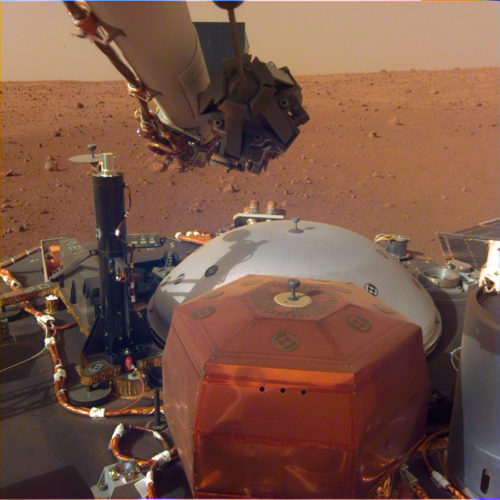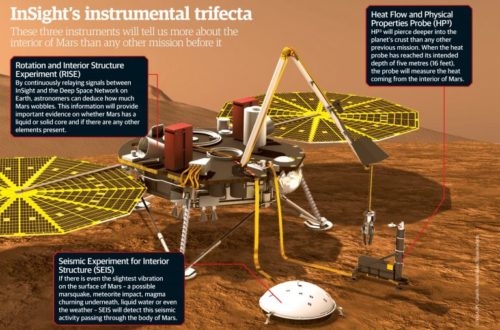
NASA’s InSight lander has been busy in its first couple weeks on the surface of Mars, testing out the deployment of some of its instruments and scanning its surroundings with its cameras. And now, it has successfully transferred its first science instrument – the seismometer – from the lander onto the ground! Back on Earth meanwhile, InSight engineers have made a rock garden to help with testing of the lander’s science instruments.
“InSight’s timetable of activities on Mars has gone better than we hoped,” said InSight Project Manager Tom Hoffman, at NASA’s Jet Propulsion Laboratory in Pasadena, California. “Getting the seismometer safely on the ground is an awesome Christmas present.”
Last Tuesday, December 18, engineers sent the radio commands to the spacecraft. On December 19, the seismometer – Seismic Experiment for Interior Structure (SEIS) – was carefully life from its resting place on the lander and gently placed on the ground, about 5.367 feet (1.636 meters), away from the lander.




“Seismometer deployment is as important as landing InSight on Mars,” said InSight Principal Investigator Bruce Banerdt, also based at JPL. “The seismometer is the highest-priority instrument on InSight: We need it in order to complete about three-quarters of our science objectives.”
Before sending the commands to the spacecraft, the engineers conducted tests on a model of the lander in a testbed at JPL – the “rock garden.” The rock garden is modeled on images taken by the lander, to simulate its immediate surroundings. By doing so, the engineers can figure out the best places on the ground to deploy the instruments where they won’t get caught on rocks. The team raked, shoveled and patted down a bed of crushed garnet to simulate the Martian sand – called “Marsforming.”
“It’s great for the science we want to do,” said Marleen Sundgaard at JPL, who is guiding the test-bed work. “It’s the flat parking lot the landing team promised us. You calculate the probability of rocks in the area and hope the odds are in your favor.”


“All around us, there are rocks that were ejected from nearby craters. These can be launched miles across the landscape, depending on the impact size,” said Nate Williams, a JPL post-doctoral researcher working with the mission. “Thankfully, there just aren’t a lot of rocks right in front of us.”
One field of small boulders is only about 70 feet (21 meters) from the lander, which would have made the landing precarious.
The seismometer is a key instrument on InSight, designed to look for evidence of marsquakes in the planet’s interior.
“Having the seismometer on the ground is like holding a phone up to your ear,” said Philippe Lognonné, principal investigator of SEIS from Institut de Physique du Globe de Paris (IPGP) and Paris Diderot University. “We’re thrilled that we’re now in the best position to listen to all the seismic waves from below Mars’ surface and from its deep interior.”
Unlike Curiosity and the MER rovers Opportunity and Spirit, InSight is a stationary lander. Its mission is to probe the interior of Mars, without moving, looking for signs of geological activity deep below the surface and clues as to how Mars first formed and evolved over billions of years. By necessity, it needed to land in a flat area with few rocks in order to carry out these science tests, which is why the photos are not as “scenic” as those from the rover missions.


The mission team now expects to deploy the heat probe instrument (HP3) by late January.
“We look forward to popping some Champagne when we start to get data from InSight’s seismometer on the ground,” said Banerdt. “I have a bottle ready for the occasion.”
InSight was also recently photographed from orbit by the Mars Reconnaissance Orbiter. The images clearly show the parachute, lander and heat shield on the ground.
InSight made a perfect landing on Mars on Nov. 26, 2018 in Elysium Planitia.
More information about InSight is available on the mission website.





